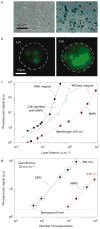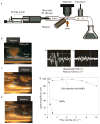In vivo magnetic enrichment and multiplex photoacoustic detection of circulating tumour cells
- PMID: 19915570
- PMCID: PMC3663137
- DOI: 10.1038/nnano.2009.333
In vivo magnetic enrichment and multiplex photoacoustic detection of circulating tumour cells
Abstract
The spread of cancer cells between organs, a process known as metastasis, is the cause of most cancer deaths. Detecting circulating tumour cells -- a common marker for the development of metastasis -- is difficult because ex vivo methods are not sensitive enough owing to limited blood sample volume and in vivo diagnosis is time-consuming as large volumes of blood must be analysed. Here, we show a way to magnetically capture circulating tumour cells in the bloodstream of mice followed by rapid photoacoustic detection. Magnetic nanoparticles, which were functionalized to target a receptor commonly found in breast cancer cells, bound and captured circulating tumour cells under a magnet. To improve detection sensitivity and specificity, gold-plated carbon nanotubes conjugated with folic acid were used as a second contrast agent for photoacoustic imaging. By integrating in vivo multiplex targeting, magnetic enrichment, signal amplification and multicolour recognition, our approach allows circulating tumour cells to be concentrated from a large volume of blood in the vessels of tumour-bearing mice, and this could have potential for the early diagnosis of cancer and the prevention of metastasis in humans.
Figures





Comment in
-
Nanomedicine: detecting rare cancer cells.Nat Nanotechnol. 2009 Dec;4(12):798-9. doi: 10.1038/nnano.2009.367. Nat Nanotechnol. 2009. PMID: 19966826 No abstract available.
Similar articles
-
In vivo ultra-fast photoacoustic flow cytometry of circulating human melanoma cells using near-infrared high-pulse rate lasers.Cytometry A. 2011 Oct;79(10):825-33. doi: 10.1002/cyto.a.21102. Epub 2011 Jul 22. Cytometry A. 2011. PMID: 21786417 Free PMC article.
-
Nanotechnology-based molecular photoacoustic and photothermal flow cytometry platform for in-vivo detection and killing of circulating cancer stem cells.J Biophotonics. 2009 Dec;2(12):725-35. doi: 10.1002/jbio.200910078. J Biophotonics. 2009. PMID: 19957272 Free PMC article.
-
Capture and Isolation of Circulating Melanoma Cells Using Photoacoustic Flowmetry.Methods Mol Biol. 2021;2265:203-212. doi: 10.1007/978-1-0716-1205-7_15. Methods Mol Biol. 2021. PMID: 33704716
-
Photoacoustic flow cytometry.Methods. 2012 Jul;57(3):280-96. doi: 10.1016/j.ymeth.2012.06.009. Epub 2012 Jun 26. Methods. 2012. PMID: 22749928 Free PMC article. Review.
-
Markers of circulating breast cancer cells.Adv Clin Chem. 2013;61:175-224. doi: 10.1016/b978-0-12-407680-8.00007-5. Adv Clin Chem. 2013. PMID: 24015603 Review.
Cited by
-
Enhancement of the blood-circulation time and performance of nanomedicines via the forced clearance of erythrocytes.Nat Biomed Eng. 2020 Jul;4(7):717-731. doi: 10.1038/s41551-020-0581-2. Epub 2020 Jul 6. Nat Biomed Eng. 2020. PMID: 32632229
-
Recent Advances in Photoacoustic Imaging: Current Status and Future Perspectives.Micromachines (Basel). 2024 Aug 4;15(8):1007. doi: 10.3390/mi15081007. Micromachines (Basel). 2024. PMID: 39203658 Free PMC article. Review.
-
In Vivo Lymphatic Circulating Tumor Cells and Progression of Metastatic Disease.Cancers (Basel). 2020 Oct 5;12(10):2866. doi: 10.3390/cancers12102866. Cancers (Basel). 2020. PMID: 33028044 Free PMC article.
-
Plasmonic Nanoparticle-Enhanced Optical Techniques for Cancer Biomarker Sensing.Biosensors (Basel). 2023 Nov 8;13(11):977. doi: 10.3390/bios13110977. Biosensors (Basel). 2023. PMID: 37998152 Free PMC article. Review.
-
Ferritin as a novel reporter gene for photoacoustic molecular imaging.Cytometry A. 2012 Oct;81(10):910-5. doi: 10.1002/cyto.a.22160. Epub 2012 Sep 4. Cytometry A. 2012. PMID: 22949299 Free PMC article.
References
-
- Christofori G. New signals from the invasive front. Nature. 2006;441:444–450. - PubMed
-
- Pantel K, Brakenhoff RH, Brandt B. Detection, clinical relevance and specific biological properties of disseminating tumour cells. Nature Rev Cancer. 2008;8:329–340. - PubMed
-
- Riethdorf S, et al. Detection of circulating tumor cells in peripheral blood of patients with metastatic breast cancer: a validation study of the CellSearch system. Clin Cancer Res. 2007;13:920–928. - PubMed
-
- Georgakoudi I, et al. In vivo flow cytometry: a new method for enumerating circulating cancer cells. Cancer Res. 2004;64:5044–5047. - PubMed
Publication types
MeSH terms
Grants and funding
LinkOut - more resources
Full Text Sources
Other Literature Sources

